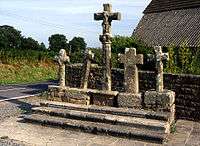The Five Crosses
The Five Crosses (in French, Les Cinq Croix) are a set of stone crosses at Ploubezre, near Lannion, Côtes-du-Nord, in Brittany, France, classified as a historic monument by a decree of 7 December 1925 and, as a group, attributed to the 18th century.[1]

The central cross is placed on a tall pillar and has a figure of Christ on one side and of Mary the mother of Jesus on the other. The other crosses are plain except for that immediately to the right of the central cross, which bears the date 1728.[2][3] The base of another is inscribed with the date 1733.[4]
Differing accounts attribute the central cross to the 15th or 16th century and consider the others to be medieval, while local lore has it that they were erected to commemorate a victory over English invaders. It is also said that they were assembled from various nearby places by the rector of the church to preserve them from destruction or on the occasion of a religious mission, perhaps in 1728 or 1733.[3][4][5][6][7]
The 1826 land survey shows that at that time the crosses stood, with a different orientation, along the road at about 25 metres from their present position.[3]
Interpretation by E. W. Bullinger
Groups of crosses are found also in other parts of Brittany gathered together for reasons that are now difficult to explain.[8] Examples are a pair in front of a chapel at Croaziou[9] and three at Pont Hir.[10]
However, the English theologian E. W. Bullinger (1837–1913) attached special significance to the group of five at Ploubezre, claiming that it was a confirmation of his theory that Jesus was crucified with four, not just two, criminals: two thieves and two other malefactors.[11]
Another Cinq Croix
Outside of Brittany, another French Cinq Croix (Five Crosses) exists, reputedly a monument to five brothers killed in the 11th century in battle against William the Conqueror. Unlike those at Ploubezre, these five crosses are not placed side by side. The monument is at the intersection of route D933 (Route de Houdan) and D136 north toward Marchefroy.[12]
References
- Annuaire des villes de France: Les monuments historiques de la ville de Ploubezre (22300)
- Patrimoine de France: Cinq croix à Ploubezre
- Infobretagne: Patrimoine de Ploubezre
- Ploubezre entre passé et avenir: le patrimoine bâti
- Ploubezre(22)-Le Calvaire des Cinq Croix
- Les Cinq Croix: quotation from J. Rigaud (1890)
- Calvaires
- Eugène Royer, Calvaires bretons (Editions Jean-paul Gisserot, 1991), p. 6
- Commune de Loctudy: Chapelle Notre Dame-Du-Croaziou
- Plounérin: L’assemblage des Croix de Pont Hir
- E. W. Bullinger. "The Companion Bible, Appendix 164: The "Others" Crucified With The Lord (Matt. 27:38 and Luke 23:32)".
Misled by tradition and the ignorance of Scripture on the part of medieval painters, it is the general belief that only two were crucified with the Lord. But Scripture does not say so...it is clear [from cited Scriptural evidence] that there were four "others" crucified with the Lord...To show that we are not without evidence, even from tradition, we may state that there is a "Calvary" to be seen at Ploubezere near Lannion, in the Cotes-du-Nord, Brittany, known as Les Cinq Croix ("The Five Crosses"). There is a high cross in the center, with four lower ones, two on either side.
- M. Jules Job, "Les cinq croix de France à Saint Ouen de Marchefroy